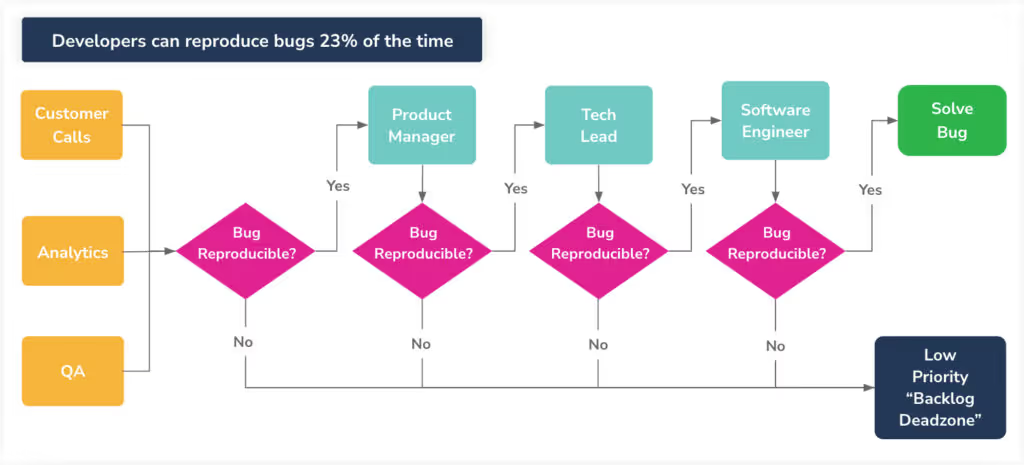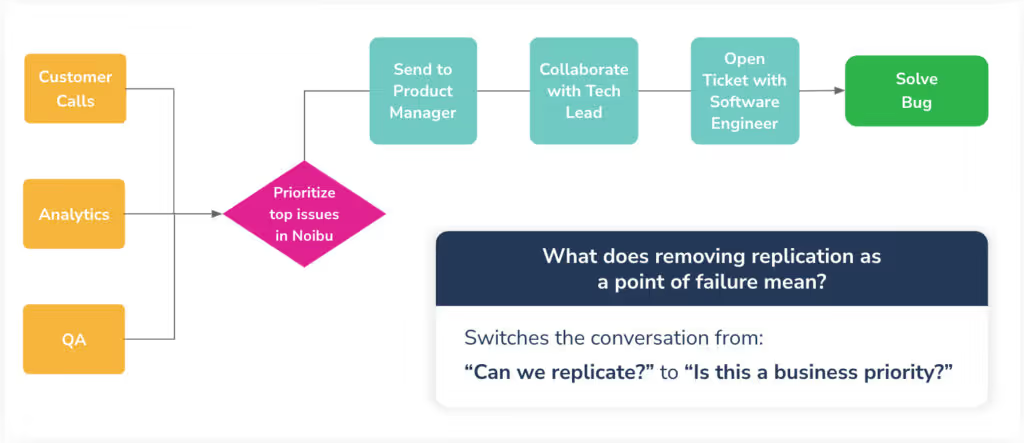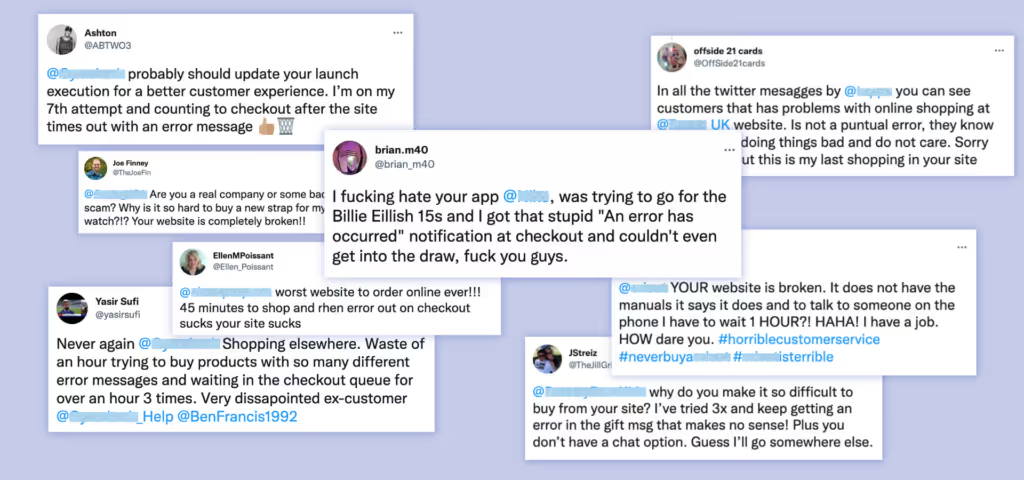The top 8 most common challenges Noibu solves for retailers

“Error Detection and Revenue Recovery” sounds nice… But how do the functionalities associated with those terms actually work to solve today’s challenges? Hopefully this piece will give you a good idea of the most common challenges ecommerce brands face that Noibu’s software can solve.
First, before we go over the challenges one-by-one, let me give you the world’s quickest product overview:
Noibu grabs all the errors on your ecommerce site that happen to real customers. We rank them by how much they hurt revenue, then produce all the information your development team needs to resolve the errors.
So that’s the general spiel. Now let’s break down how those functionalities work to solve the challenges you’re facing today.

1. The support ticket challenge
How often is your support team getting tickets submitted that say something along the lines of, “What the heck?! I’ve been trying to buy something from your site but it keeps breaking!”
That’s not a lot of information to work with, right?
Even if your team gets a ticket that has a bit more information, such as “a product page wasn’t loading,” or, “I can’t input my shipping details,” your team is still missing critical information that would allow them to identify the root cause of the problem. (Think: what browser, what device, which product or item, what mode of payment, what time, what user flow was this particular customer using?)
Unless your potential customers are naturally tech savvy and know exactly the information to include in a support ticket (*most folks don’t), more often than not your support team is going to be stuck knowing there’s an issue but not know where, how, or why. Their options are to spend the next few hours looking into the issue to hopefully identify what occurred, pass the vague message off to the engineering team to figure out, or just ignore it altogether.
Noibu allows support teams to dive into the console to pinpoint any error based on (even vague) identifiable markers included in tickets, view full session recordings, see the level of impact to business revenue the error is causing so the team can better understand which fixes need to be prioritized, and pull the entire stack trace associated with an error so they or the engineering team can immediately get to resolving the issue without losing hours trying to find the issue.

2. The visibility challenge
Did you know that only 10% of customers take the time to submit a support ticket when something breaks during their online experience?
With that in mind, your support tickets will realistically cover only a small portion of usability issues. The rest are left to be picked up by an error monitoring software or are simply left in the dark.
While other softwares focus on the “users impacted” portion of an error and highlight only the bugs that are widespread on your site, Noibu brings on another layer of analytics that takes things a step further.
Noibu’s software monitors all errors, at all times, throughout your site. Regardless of how widespread a bug is, the error will be recorded and its impact to revenue calculated.
While “users impacted” is certainly a legitimate concern and is a decent way to know which errors are more pressing, the ultimate goal of the users impacted metric is to estimate the truly meaningful hit to the business: loss of revenue due to said error.
Noibu gets you that, and more…

3. The support to engineering handoff challenge
Engineers are the backbone of ecommerce stores, and ensuring they can do their job as efficiently and effectively as possible should always be a priority.
As mentioned previously with the support ticket challenge, handing off vague requests for resolutions with limited contextual data off to the engineering team can sour the relationship between support and engineering.
With no additional data besides, “Something is broken on the website, can you fix it?” engineers have to sink a lot of behind-the-scenes work into identifying what went wrong, how it went wrong, and what is needed to resolve it.
With Noibu packaging up everything engineers need to know to kick-off their resolution process, support’s emails no longer have to be received with dread by the development team.

4. The root cause analysis challenge
With thousands of applications, softwares, and devices used to run your ecommerce store, it can be a next to impossible task to find out the exact root cause of any one error once detected.
Noibu’s software picks up on that, and displays the root cause to your developers (along with everything else they need, including full session replay and stack traces) on a silver platter, simple as that.

5. The prioritization challenge
AKA The data-driven vs subjective prioritization challenge
Imagine: The CEO’s husband is trying to order something from the online store and experiences a site bug. He tells his partner and they call up their Director of Development to say x, y, z is broken on the site and needs fixing ASAP. The engineering team spends a few hours trying to recreate the issue then work to come up with a resolution.
Conversely, there’s an error that has been detected by a software, but it isn’t really widespread and there’s a new project planned for the development sprint, so the issue is put on the backlog to be dealt with later.
At face value, it’s obvious that the company should work on the error that the CEO’s husband experienced. But how do you know whether or not the error was actually impactful to the business?
The issue is, when there isn’t any data to back up a decision, you’re stuck relying on gut-feel and seniority to determine what’s important and what gets fixed when… And without the proper data, you could be prioritizing superficial fixes and de-prioritizing fixes with a large impact to the business.
As being data-driven is at the forefront of every smart business-leader’s mind, it only makes sense to arm yourself with as much relevant data as you can. Noibu is the only detection software that provides users with revenue impact data - which is ultimately the most important metric when it comes to an ecommerce business.
This additional piece of data allows Noibu users to make objective decisions based solely on hard revenue numbers, without being clouded by outside pressures.

6. The reproduction workflow challenge
It is estimated that anywhere between 35% to 50% of a developers’ time is spent on debugging and validation efforts.
“The cost of debugging, testing, and verification is estimated to account for 50-75 percent of the total budget of software development projects, amounting to more than $100 billion annually.”
Devon H. O'Dell
When your development team gets an error ticket from the support team, what does their workflow look like? How many rounds of reproduction does the team need to go through before they can validate an error and tackle a resolution?
The typical error reproduction process looks very similar to this chart below:

So, if at any one of those steps, someone is unable to fully reproduce the error, it’s thrown into the backlog. There are 2 major problems with this.
First, how many hours did it take to get to that failure point? How much time did your developers use trying and retrying to see the reported error in “real time”?
*For context: In a survey of 900+ developers, researchers found that 32% of developers spend up to 10hr/wk, and 16% say they spend 15hr/wk, on bug fixes instead of writing code.
Second, just because the team failed to replicate the error properly once, doesn’t mean the error isn’t valid or doesn’t have a real, ongoing impact to the business.
Bringing on Noibu, your team can immediately cut out this key bottleneck in their everyday workflow.
Because of how the Noibu tag captures errors, there is no longer a need to reproduce and reaffirm site bugs. Everything needed to validate, view in “real-time”*, and analyze for root cause is captured and packaged together within the console under the error signature.
*view a recording caught of the error happening to a real customer in real time
All in all, taking the process from what we see above, to the streamlined workflow down below:


7. The conversion rate optimization challenge
If something fails in your backend, if there’s a new bug introduced into your system, if a <div> tag is missing, if JavaScript has failed, or any number of other instances occur, it can affect your website in a handful of different ways.
A system’s failure or an integration bug can alter the way images load on your website, can move around assets in unprecedented ways, can create blank pop-ups, or can null-ify clicks and button responsiveness.
Any of those have a direct impact on page conversion rates… Be it because the conversion action won’t load and the goal tag can’t fire, because there is now too much un-structured noise on the page that the ultimate CTA is no longer a main focus, or because the error causes such frustration that prospects leave the page.
Having Noibu in place to pick up on all errors, teams concerned with UX and conversion optimization can quickly jump into the console to ensure there are no issues blocking prospects from completing their conversion actions, and can know that they will be alerted to any outside changes that have had an adverse affect on their pages.

8. The brand challenge
You have a bad experience, you tell 10 people. You can also post about it publicly to spread the word.
It’s not uncommon now for people, instead of submitting support tickets (as mentioned above), to take to social media to complain about broken ecommerce flows. Some folks are understanding about it…

Others? Not so much…

It’s pretty safe to assume that a good portion of the frustrated customers that couldn’t complete their purchases are a lot less likely to come back to the same site to buy more.
And the thing is, unlike a support ticket, other potential customers are also seeing the public complaints on social media. And that doesn’t really build a lot of confidence, does it?
So not only has the brand lost that sale with that one customer, but they’ve also lost future sales from them and from those that have seen the complaint!
Noibu works to solve this challenge by enabling your teams to have a full view into all site errors, so they can be proactive with fixes before it starts affecting customers’ opinions of your brand.
Summary
So that's a relatively quick look at how Noibu helps ecommerce brands recover potentially lost revenue, streamline engineer workflows, increase conversions, decrease customer churn, improve the support and engineering teams' relationship, save time, gain visibility into site health, and become more data-driven.
Interested in how this all works, and how you can get it to work for you? You can request a short demo with one of our ecommerce experts, or send us a note at info@noibu.com.




